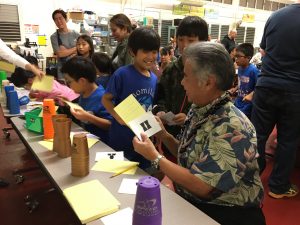‘Education is at the heart of our future,’ says governor
Posted on Feb 27, 2017 in FeaturedSchool empowerment and innovation aren’t just buzzwords. They’re part of Gov. David Ige’s long-held belief that our school system needs to direct more resources to those closest to the students. That’s why education is his priority in the state’s 2017-2019 biennium budget. “Improving education pays dividends for everyone in Hawai‘i,” says the governor. “The students’ success can have ripple effects for generations to come.” So how do empowerment and innovation translate in the real world for students, teachers, schools and communities? This issue provides some answers – and insight on the governor’s long-standing commitment to education reform.
Q. Why is education such a priority for you?
A. My parents always said education was the ticket to success. My father went through 8th grade on Ewa Plantation, and that was it. My mom grew up on Kahuku Plantation and wanted to become a nurse so she left home at age 15 to train on the mainland. Their work ethic and sacrifice made it possible for my brothers and me to earn our college degrees. That belief in the value of education is why I’ve worked so hard over the past 25 years to help strengthen our public school system. Our amended biennium budget provides increases in targeted areas and more funds that principals can control. It also includes more funding to improve school facilities and cool more classrooms.
Q. Why are “empowerment” and “innovation” so important for the public schools?
A. Initiative, empowerment and innovative thinking are the qualities our students need to succeed in the 21st century. The world is changing so fast, we need more than a one-size-fits-all model. We’re focused on getting more funds directly to the schools through the Weighted Student Formula and a new Innovation Grant program as well as successful initiatives such as Early College and Hawai‘i’s Promise to help students with college funding. We can’t rely on a top-down approach where a state office is telling the schools what they can or can’t do. It also has to come from the principals, teachers, students and the community finding ways to get students excited about the basics of reading, writing and math while they’re learning coding, digital media, science and the arts.
Q. How can we help schools share and support innovative ideas?
A. Our proposed Innovation Grant encourages schools to develop new ideas that couldn’t be carved out of their base budgets but could help students statewide. Some examples of folks who took it upon themselves to find their own funding outside the DOE system are teachers like Candy Suiso who started Waianae High School’s Searider Productions or principals like Keith Hayashi who launched Early College at Waipahu High School. They had to find grants from community partners to develop it on their own.
Q. What do you think of the teachers union proposal to use a percentage of the property tax for education?
A. I’m intrigued by their proposal. We’re the only state where we get zero dollars for education from property taxes. We know we can’t meet all of the DOE’S construction needs and operating costs. I’m open to finding ways to fund fair wages for our teachers.
